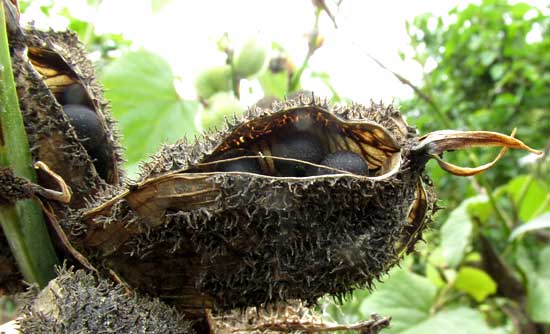Excerpts from Jim Conrad's
Naturalist Newsletter
from the May 29, 2016 Newsletter with notes from a visit to Lacanja Chansayab in the Lacandon Reserve, Chiapas, MÉXICO
WILD CANNA LILY
Last April 14th as I hiked little gravel roads around the Lacandon community of Lacanja Chansayab in Chiapas's Lacandon Reserve in extreme southeastern Mexico, I passed through a marshy area that was luxuriously green and weedy, despite it being the heart of the dry season. Amid all the greenness a single tiny burst of red caught my eye. Maybe you can see it below:

The red spark resides atop one of two slender stems bearing broad, glossy leaves of the kind often seen in gardens in warmer parts up north. They look like canna-lily leaves. In fact, the red flower turned out to be a canna flower, shown below:

Canna flowers are pretty, but so different from most flowers that they're hard to interpret. You can check our our special Canna Flowers Page at www.backyardnature.net/fl_canna.htm
Basically, the blossom's sepals are small, usually greenish, and not amounting to much. The three petals usually are colorful, but they're slender and don't constitute the most conspicuous part of the flower. In the above picture you can see three of them, more or less in the picture's center. They're stiff-looking and narrow.
In the picture, the three longest, broadest, variously curling, red items are modified stamens, sometimes called staminodia, and usually there are five of them. Sometimes they're called "false petals." The two broad, curling, red things occupying the picture's top, right corner are false petals. The false petals' job is to attract pollinators with their color.
Also in the picture you can see that one false petal bears a narrow, stiff, yellow, pollen-producing anther-cell, so at least one false petal also produces pollen. You can see the yellow anther-cell on the picture's right side, positioned horizontally. The flower's female stigma is the dark, slender object below the yellow anther-cell.
Mid April must be late in this Canna's flowering season, for I couldn't find another flower. However, several plants bore typically burry canna fruit-capsules, a couple shown below:

Some fruits were even mature enough to be splitting open, revealing spherical, blackish seeds inside, ready to spill out if anything such as wind or an animal shook the plant, shown below:

So, had these canna plants been planted there, or had they invaded as weeds, or were they native? They sure didn't look planted, and I just wasn't sure whether they were invasive weeds or native wildflowers. The first step to figure out that question was to identify our plants to species level, so that their native distribution area could be looked up.
These are CANNA INDICA, sometimes called Wild Canna Lily, and though their exact origin is unknown, it's believed they probably are native to tropical America from Mexico, Central America and the Caribbean, well into South America. The plant is so favored because of its prettiness that it's been planted and "gone wild" throughout the world's tropics. Its habitat is described as swamp and wetland edges, streambanks and other moist areas, exactly as where we found it. In some places Wild Canna Lily grows so thickly along streams that it reduces water flow, causing flooding and limiting access to waterways. In South Africa it's listed as a noxious weed.
Several canna garden cultivars are very similar to our Wild Canna Lily. In general the cultivars can be distinguished by their broader anther-cell-bearing false petals. Most cultivar blossoms also are much larger than on our Chiapas species.
In Mexico sometimes Wild Canna Lily leaves are wrapped around tamales, and certain forms produce starchy rhizomes that can be eaten.